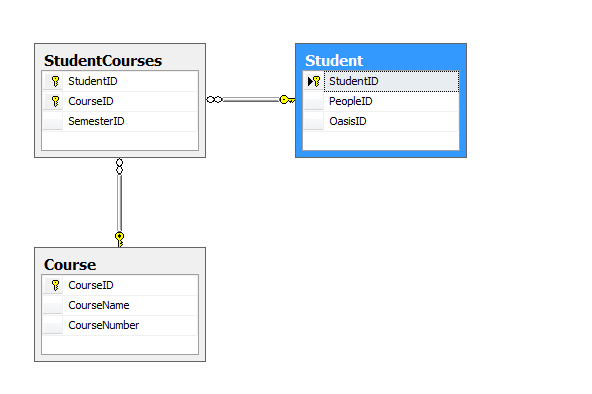Difference between revisions of "DD Class11"
(→Logon Using the tables we made last week) |
(→HomeWork) |
||
| Line 227: | Line 227: | ||
http://iam.colum.edu/oop/classsource/class14/mail.aspx | http://iam.colum.edu/oop/classsource/class14/mail.aspx | ||
[[http://iam.colum.edu/oop/gbrowser.php?file=/classsource/class14/mail.aspx -source]] | [[http://iam.colum.edu/oop/gbrowser.php?file=/classsource/class14/mail.aspx -source]] | ||
| + | |||
| + | C:\Windows\Microsoft.NET\Framework\v2.0.50727>aspnet_regsql.exe | ||
==HomeWork== | ==HomeWork== | ||
Revision as of 19:16, 17 November 2008
Contents
Authentcation
Authentication Discuss Methods and problems
Methods
- Windows
- Passport
- Forms
The authentication method is set in the root web.config <xml> <authentication mode="Forms">
<forms loginUrl="logon.aspx"
timeout="20" path="/"
protection="All">
</forms>
</authentication> </xml>
We will be using a small section of the .net provider model.S
Logon Using the tables we made last week
You can use the Authorization Section of web.config to protect file or a directory. You can have more than one web.config in a project also. You can have one for each folder. The web.config setting inherit from the parent folder and most section can be overridden. Here is an example of a small web.config that protects a folder call admin with the .net authentication mechanism.
http://iam.colum.edu/dd/gbrowser.php?file=/classsource/Logon/Web.config
Main web.config add the following to the system.web section <xml> <system.web>
<authentication mode="Forms">
<forms loginUrl="classsource/logon/logon.aspx" name="adAuthCookie" timeout="20" path="/" protection="All"> </forms>
</authentication>
</system.web>
</xml>
Now any link to the admin folder
http://iam.colum.edu/dd/classsource/logon/admin/
should redirect to the logon page
Logon Page
http://iam.colum.edu/dd/classsource/Logon/Logon.aspx - source http://iam.colum.edu/dd/gbrowser.php?file=/classsource/Logon/Logon.aspx.cs
Add a New user page http://iam.colum.edu/dd/classsource/Logon/CreateAccount.aspx -source http://iam.colum.edu/dd/gbrowser.php?file=/classsource/Logon/CreateAccount.aspx.cs
Admin Page http://iam.colum.edu/dd/classsource/Logon/Admin/Default.aspx - source http://iam.colum.edu/dd/gbrowser.php?file=/classsource/Logon/Admin/Default.aspx.cs
Logon the Microsoft way
Sql Aggregate Functions
They perform a calculation on a set to values and return a single value. Aggregate functions are determinate. They will return the same value given the same dataset.
- AVG
- MIN
- CHECKSUM
- SUM
- CHECKSUM_AGG
- STDEV
- COUNT
- STDEVP
- COUNT_BIG
- VAR
- GROUPING
- VARP
- MAX
<sql> SELECT MAX(PricePerPound) as MaxPrice from CheesePrice
SELECT AVG(PricePerPound) as AvgPrice from CheesePrice
SELECT COUNT(CheeseID) as Count from CheesePrice </sql>
Sub Query
A query may be a part of another query. This allows
IN vs EXSISTS
Remember the Many to Many relation ship in the Student Registration System
Here a student has many course and a course has many student. Imagine in the registration system the student will be presented with a list of classes that they can add. That list of classes should not include the courses that they are already taking. Course
| CourseID | CourseName | CourseNumber |
|---|---|---|
| 9 | Science | 66-0002 |
| 10 | Math | 66-0001 |
| 11 | Data Design | 36-2601 |
| 168 | Application Design | 36-4601 |
| 169 | OOP | 36-2001 |
Student
| StudentID | PeopleID | OasisID |
|---|---|---|
| 1 | 1 | 666666 |
| 2 | 2 | 777777 |
StudentCourses
| StudentID | CourseID | SemesterID |
|---|---|---|
| 1 | 9 | 1 |
| 2 | 9 | 1 |
| 1 | 10 | 1 |
StudentsCourses_vw <sql> SELECT dbo.Student.PeopleID, dbo.Student.OasisID, dbo.StudentCourses.SemesterID, dbo.Course.CourseName,
dbo.Course.CourseNumber, dbo.Student.StudentID, dbo.Course.CourseID
FROM dbo.StudentCourses INNER JOIN
dbo.Student ON dbo.StudentCourses.StudentID = dbo.Student.StudentID INNER JOIN dbo.Course ON dbo.StudentCourses.CourseID = dbo.Course.CourseID
</sql>
<sql> SELECT CourseID, CourseName, CourseNumber FROM Course WHERE (
CourseID not in
(
SELECT CourseID FROM StudentsCourses_vw WHERE StudentID = @StudentID
)
) </sql>
This query has two parts
SELECT CourseID FROM StudentsCourses_vw WHERE StudentID = 1
returns
| CourseID |
|---|
| 9 |
| 10 |
then
<sql> SELECT CourseID, CourseName, CourseNumber FROM Course WHERE (
CourseID NOT IN
(
SELECT CourseID FROM StudentsCourses_vw WHERE StudentID = 1
)
) </sql>
returns
| CourseID | CousreName | CourseNumber |
|---|---|---|
| 11 | Data Design | 36-2601 |
| 168 | Application Design | 36-4601 |
| 169 | OOP | 36-2001 |
Course adder example
http://iam.colum.edu/dd/classsource/class8/student.aspx
SQL Subquery
Send Mail
<csharp><% @Page Language="C#" %> <% @Import Namespace="System.Web.Mail" %> <%
//set up some strings for the email string strTo = "only_a_test@fastmail.fm"; string strFrom = "jeff@interactive.colum.edu"; string strSubject = "Hi jeff"; string strBody = "A real nice body text here"; //Send email SmtpMail.SmtpServer = "localhost"; SmtpMail.Send(strFrom, strTo, strSubject, strBody);
%></csharp> http://iam.colum.edu/oop/classsource/class14/mail.aspx [-source]
C:\Windows\Microsoft.NET\Framework\v2.0.50727>aspnet_regsql.exe
HomeWork
Web Skeleton of your site
Demonstrate one feature

